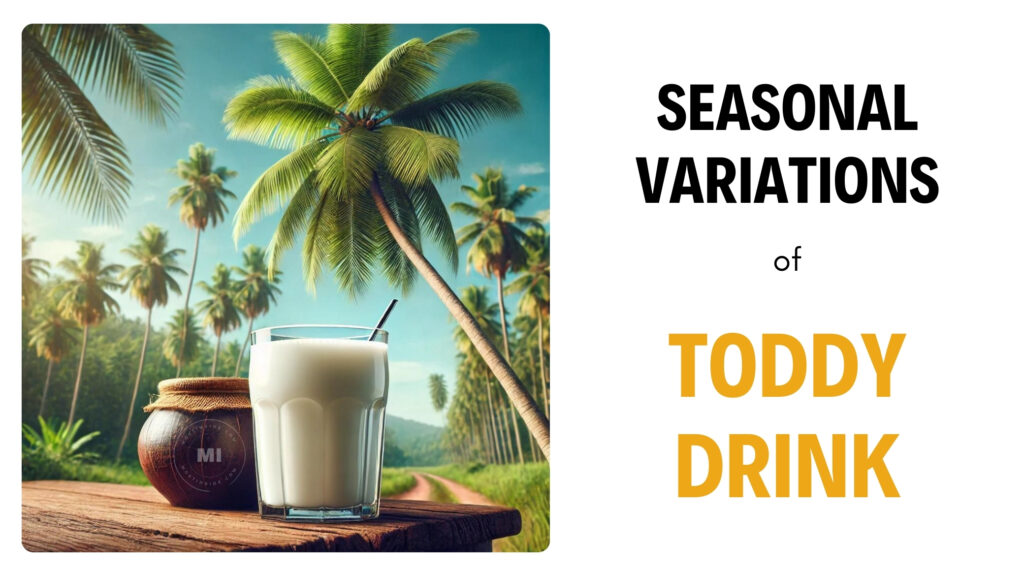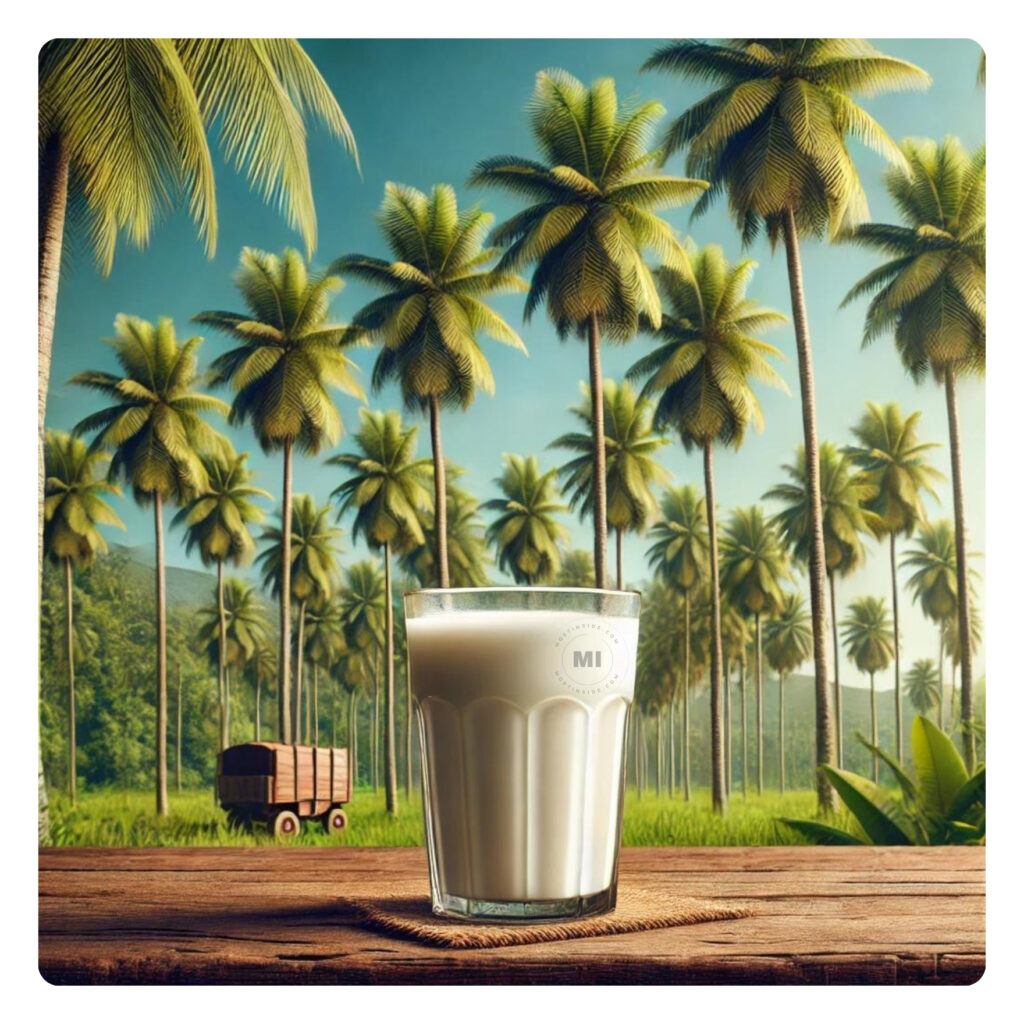Seasonal Variations of Toddy Drink: Best Times to Enjoy
This post was last updated on January 14th, 2025
Toddy is extracted from the sap of coconut trees or palm trees. It is a rural drink very commonly found in the villages of India for centuries. It is known as toddy in Kerala, Telangana and Andhra Pradesh and as Neera in North India.

In this article, we explore the origins and the seasonal variations of toddy drink.
Understanding Toddy
There are alcoholic and non alcoholic types of palm sap. In Kerala, it is known as Palm wine, Kallu, and palm toddy and is usually alcoholic. Non-alcoholic toddy is obtained from date palm, and coconut palm immature inflorescence is sweet when freshly tapped. After fermentation it becomes alcoholic.
The sap must be collected in a clean pot else fermentation occurs rapidly. Fermentation occurs after a day or two and there is an increase in its sourness and acidic nature. Good palm trees produce up to 300 litres of toddy and as they grow older they can produce up to 400 litres of palm toddy.
Neera must be consumed immediately and some lime is added to improve its shelf life. If the toddy is left after extraction, it ferments and becomes strong. It needs to be distilled and then consumed as wine. In the Northeast, for example, Assam, bamboo plants are stuffed with plants and left for fermentation.
Historical Background
Toddy originated in Kerala and South East Asia. Early Indian texts in Tamil refer to it as Toppi, Pili, Teral, Mattu, and Ariyal. Toddy was a combination of fermented rice, honey, sap of the palm tree, and cereal. To hide the odour, some ginger was added to it. The toddy was poured into huge bamboo pots and all villagers drank from it.
One of the oldest works of Tamil literature, Tholkaapiyam mentions the use of toddy in ancient India where even women and children drank it. Kings served toddy in times of joy and celebration at lavish banquets attended by generals and poets alike. It was only the British who imposed sanctions on the consumption of toddy.
Seasonal Variations of Toddy
The coconut plant produces flowers throughout the year so there is no specific season for tapping toddy. Tapping happens throughout the year on the same trees or different trees. Some varieties of palm yield more juice during specific months of the year.
In the West Coast dry weather tapping is from November to March and wet weather tapping is from April to October. Trees that are healthy and hardy are chosen for tapping. On the West Coast, tapping is done for six months on one set of trees. In Sri Lanka and Philippines, tapping is done on vigorous trees for several years. Some trees give toddy yield throughout their lifetime. Selecting the proper tree is a skill that seasoned tappers develop with experience.
Taste and Quality Across Seasons
Fresh toddy is sweet with 4-5 % alcohol like mild beer/ It ferments naturally due to the presence of yeasts found around the palms. These yeasts impart an odor to the toddy that many people do not like. Moreover, the taste of toddy can change with the weather, the trees tapped, and the skills of the tapper.
Best Times to Enjoy Toddy

In summer toddy is available as tadgola or ice apple. It is very cool, rich in water content and has almost no fat content. Having a toddy in summer promotes weight loss as it is low in calories. Ice apple has a lot of potassium that removes toxins from the liver and is a good anti-oxidant that slows aging and gives you glowing skin.
A hot toddy is best consumed in winter as a warm comforting drink to cure coughs and colds. It is made from toddy, lemon, honey and warm water, and warming spices. You can alter the amount of lemon or honey to suit your taste buds. Hot toddy is light and hydrating and not too sweet. They are perfect for holiday parties or for a night of playing cards with friends.
Regional Differences in Seasonal Toddy
Asia
In Telangana and Andhra Pradesh people have toddy as an end-of-the-day drink. There are two main types of toddy available tadikallu made from toddy palmyra plants and kallu made from a specific type of palm tree. Tadikallu is sweeter in the morning and bitter-sweet in the evening and more intoxicating than kallu. In Karnataka and Goa it is used to make a milder type of Sanna that is very famous.
In the Philippines, distilled palm liquor is called Lambanog and it has a high alcohol content of almost 40%. Palm wines are made from nipa palm, kaong palms, and coconuts. They are fermented for a few days to a few weeks. Lambanog is distilled liquor that is white in color and bahalina is deep brown or orange in color due to the use of mangrove bark extracts.Tuhak is palm wine made from kaong palm sap and tunggang which is made from fishtail palm sap.
In Leyte, in Central Philippines, the tuba is aged with tanbark from 6 months to two years. This palm wine is called bahal for aging up to 6 months and bahalina for tuba aged more than a year.
Toddy is also widely consumed in Sri Lanka, and Bangladesh. In Indonesia Tuak or palm wine is consumed in Sumatra. Sulawesi and Bali. In Malaysia also palm wine is served during marriages, birthdays, and special occasions in the provinces of Sabah, Sarawak, and East Malaysia. It is a popular drink Gawai and Kaamatan festivals among tribes of Ibans and Dayaks.
Africa
In Nigeria, it is known as palm wine, some parts of Cameroon it is known as Emu. In Togo and Benin it is called sodabe while in Kenya it is called as mnazi. Toddy is called lagmi in Tunisia.
Palm wine plays an important role in many traditions and festivals in many tribes like the Igbo and Yoruba of Nigeria and neighbouring Cameroon. Celebrations like weddings, funerals, and birthdays are celebrated by distributing toddy to guests. Palm wine mixed with medicinal herbs is used to cure many physical complaints.
Palm wine is offered to deceased ancestors as well as a mark of respect. Poyo is a fermented drink made in Sierra Leone from various varieties of palm trees. In Congo, there are four types of palm wine. Ngasi is derived from an oil palm, dibondo from raffia palm, cocoti from a coconut palm, and mahusu from a short palm.
South America
People in Mexico consume tuba made from coconut sap in the states of Colima, Jalisco, Michoacan, and Guerrero. Tuba was introduced to Mexico from the Philippines. Tuba fresca is a popular non-alcoholic version sold in large-bottle gourds mixed with coconut milk, ice, and sugar topped with peanuts and diced fruits. Excess production of palm wine may have led to the extinction of the Chilean wine palm.
Health Benefits and Considerations
- Palm toddy when fermented is good for health as it contains zinc, potassium and vitamins B1 B2, B3 and B6.
- Vitamin B1 helps in improving vision. So people in Africa drink toddy for improved vision.
- Consuming toddy in moderation is good for heart health and can prevent heart failure.
- Potassium in toddy lowers blood pressure.
- Riboflavin or vitamin B2 is an anti-oxidant that neutralizes free radicals that cause cancer.
- Iron and Vitamin B complex in toddy give a shiny complexion and beautiful nails. It helps lighten skin complexion,
- Palm toddy promotes wound healing.
- Palm toddy helps relieve symptoms of flu and gives relief from coughing and sneezing.
- It promotes lactation in women. Nursing women experience a boost in milk production after consuming toddy in several parts of Africa.
Safety and Moderation in toddy consumption
- Excessive toddy consumption can harm the liver.
- Palm toddy contains ethanol that has an impact on pregnant women’s fat metabolism. The liver starts storing fat, leading to fatty liver.
- It can raise blood pressure and cause hypertension in some cases.
- It impacts the nervous system by increasing muscle contraction and stiffness in the body. Nerves can become weak if palm toddy is taken in excess.
- Too much toddy can reduce blood clotting and result in uncontrolled bleeding.
Conclusion
There are several variations of toddy drink all over the world as is clear from the discussion above. It is a traditional drink prevalent in several cultures of Asia and Africa for hundreds of years. It is best to have fresh, sweet toddy that is refreshing and good for health and also a great natural cooler.
Thus, it is time we explore natural and traditional drinks and move to a healthier lifestyle away from packaged and processed food and drinks.
Image Credit: AAPT Digital Team
(AAPTDIGITAL1010AC)
Recommended For You
12 Best Foods For A Natural Colon Cleanse
Sangati Jogwar
Sangati is a writer, poet, voracious book reader, singer, movie-buff and critic. Loves to discuss, interact and have a strong belief in spirituality.




